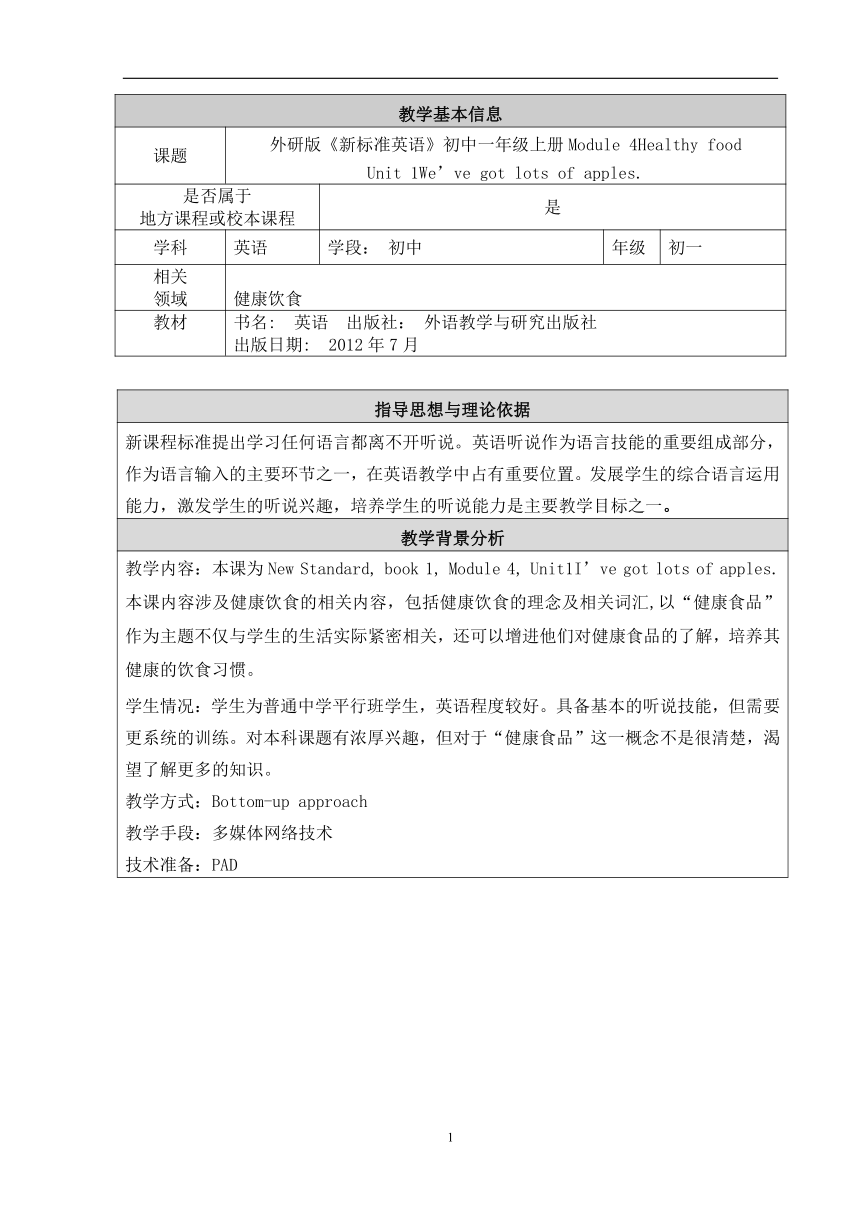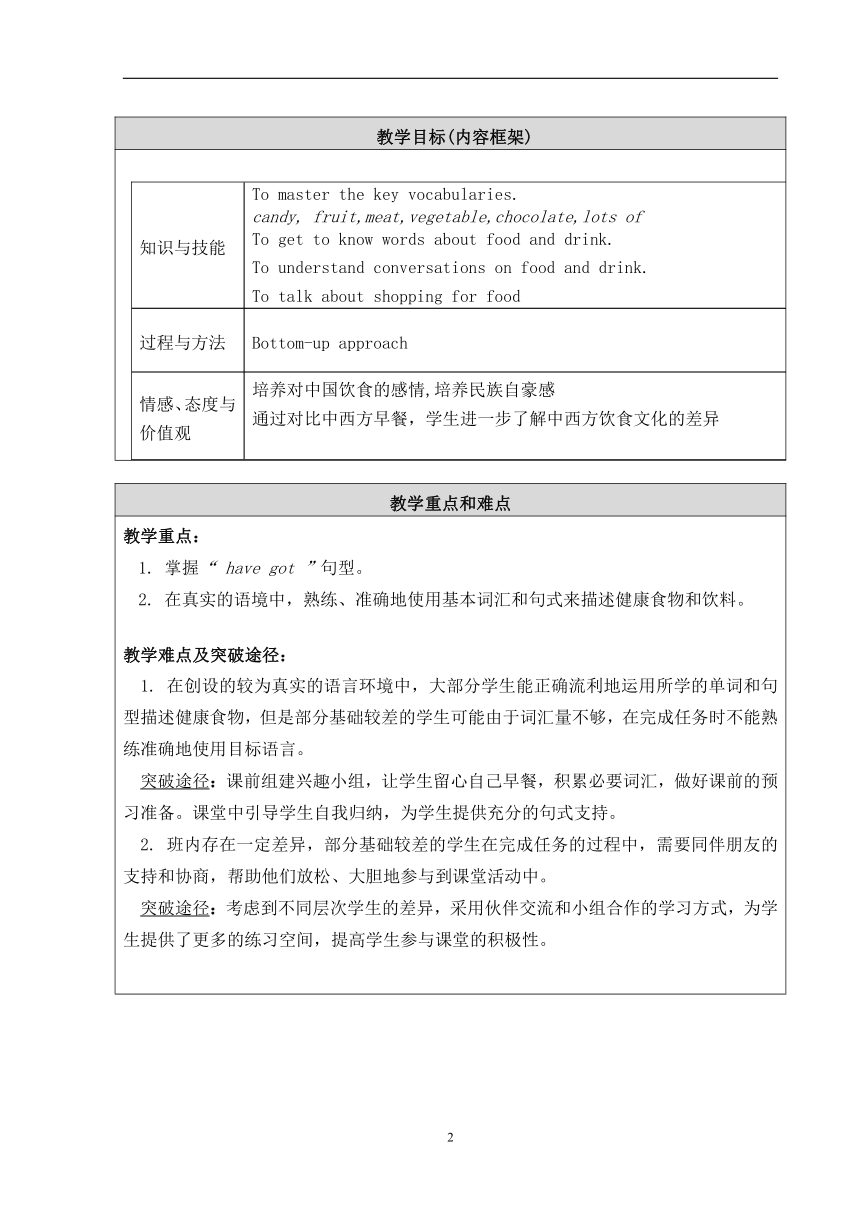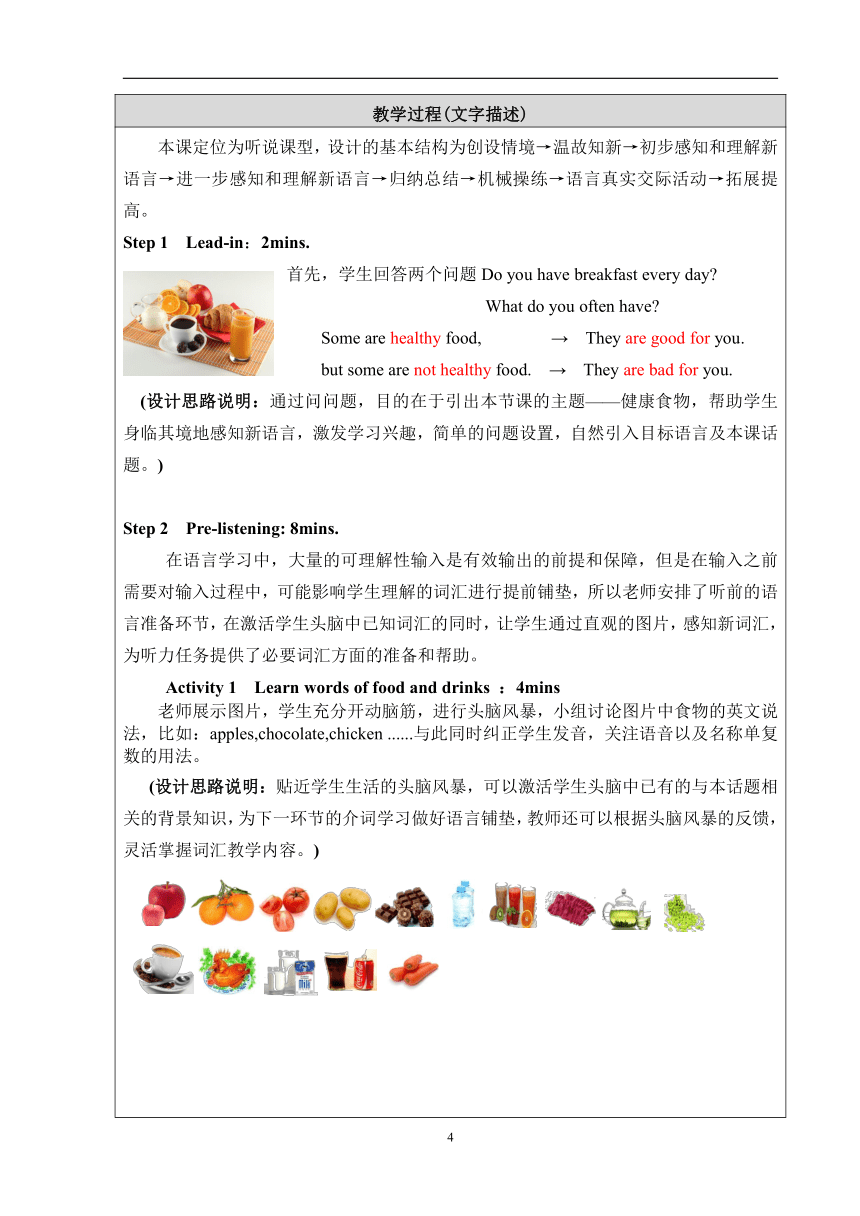外研版七年级英语上册Module 4 unit1 We've got lots of apples.表格式教案
文档属性
| 名称 | 外研版七年级英语上册Module 4 unit1 We've got lots of apples.表格式教案 |  | |
| 格式 | zip | ||
| 文件大小 | 1.6MB | ||
| 资源类型 | 教案 | ||
| 版本资源 | 外研版 | ||
| 科目 | 英语 | ||
| 更新时间 | 2020-09-15 13:41:59 | ||
图片预览





文档简介
教学基本信息
课题
外研版《新标准英语》初中一年级上册Module
4Healthy
foodUnit
1We’ve
got
lots
of
apples.
是否属于地方课程或校本课程
是
学科
英语
学段:
初中
年级
初一
相关领域
健康饮食
教材
书名:
英语
出版社:
外语教学与研究出版社
出版日期:
2012年7月
指导思想与理论依据
新课程标准提出学习任何语言都离不开听说。英语听说作为语言技能的重要组成部分,作为语言输入的主要环节之一,在英语教学中占有重要位置。发展学生的综合语言运用能力,激发学生的听说兴趣,培养学生的听说能力是主要教学目标之一。
教学背景分析
教学内容:本课为New
Standard,
book
1,
Module
4,
Unit1I’ve
got
lots
of
apples.
本课内容涉及健康饮食的相关内容,包括健康饮食的理念及相关词汇,以“健康食品”作为主题不仅与学生的生活实际紧密相关,还可以增进他们对健康食品的了解,培养其健康的饮食习惯。学生情况:学生为普通中学平行班学生,英语程度较好。具备基本的听说技能,但需要更系统的训练。对本科课题有浓厚兴趣,但对于“健康食品”这一概念不是很清楚,渴望了解更多的知识。教学方式:Bottom-up
approach
教学手段:多媒体网络技术技术准备:PAD
教学目标(内容框架)
知识与技能To
master
the
key
vocabularies.candy,
fruit,meat,vegetable,chocolate,lots
of
To
get
to
know
words
about
food
and
drink.
To
understand
conversations
on
food
and
drink.To
talk
about
shopping
for
food
过程与方法Bottom-up
approach
情感、态度与价值观培养对中国饮食的感情,培养民族自豪感通过对比中西方早餐,学生进一步了解中西方饮食文化的差异
教学重点和难点
教学重点:掌握“
have
got
”句型。
在真实的语境中,熟练、准确地使用基本词汇和句式来描述健康食物和饮料。教学难点及突破途径:
1.
在创设的较为真实的语言环境中,大部分学生能正确流利地运用所学的单词和句型描述健康食物,但是部分基础较差的学生可能由于词汇量不够,在完成任务时不能熟练准确地使用目标语言。突破途径:课前组建兴趣小组,让学生留心自己早餐,积累必要词汇,做好课前的预习准备。课堂中引导学生自我归纳,为学生提供充分的句式支持。2.
班内存在一定差异,部分基础较差的学生在完成任务的过程中,需要同伴朋友的支持和协商,帮助他们放松、大胆地参与到课堂活动中。突破途径:考虑到不同层次学生的差异,采用伙伴交流和小组合作的学习方式,为学生提供了更多的练习空间,提高学生参与课堂的积极性。
教学流程示意图
教学过程(文字描述)
本课定位为听说课型,设计的基本结构为创设情境→温故知新→初步感知和理解新语言→进一步感知和理解新语言→归纳总结→机械操练→语言真实交际活动→拓展提高。Step
1
Lead-in:2mins.首先,学生回答两个问题Do
you
have
breakfast
every
day?
What
do
you
often
have?
Some
are
healthy
food,
→
They
are
good
for
you.
but
some
are
not
healthy
food.
→
They
are
bad
for
you.
(设计思路说明:通过问问题,目的在于引出本节课的主题——健康食物,帮助学生身临其境地感知新语言,激发学习兴趣,简单的问题设置,自然引入目标语言及本课话题。)Step
2
Pre-listening:
8mins.在语言学习中,大量的可理解性输入是有效输出的前提和保障,但是在输入之前需要对输入过程中,可能影响学生理解的词汇进行提前铺垫,所以老师安排了听前的语言准备环节,在激活学生头脑中已知词汇的同时,让学生通过直观的图片,感知新词汇,为听力任务提供了必要词汇方面的准备和帮助。Activity
1
Learn
words
of
food
and
drinks
:4mins
老师展示图片,学生充分开动脑筋,进行头脑风暴,小组讨论图片中食物的英文说法,比如:apples,chocolate,chicken
......与此同时纠正学生发音,关注语音以及名称单复数的用法。
(设计思路说明:贴近学生生活的头脑风暴,可以激活学生头脑中已有的与本话题相关的背景知识,为下一环节的介词学习做好语言铺垫,教师还可以根据头脑风暴的反馈,灵活掌握词汇教学内容。)Activity
2
Put
the
words
of
food
and
drink
into
groups
:4mins运用iPad将食物和饮料进行分类,学生只需用手指触碰屏幕拖动即可,很大程度上激发了学生对英语的学习热情,即在玩中学。“玩游戏”的同时学习食物的名称并进行归类。
(设计思路说明:掌握新词,并将词类进行分组,为之后听力任务搭建台阶。运用PAD将图片推送给学生。)Step
3
While-listening:
20mins.
Activity
1
Listen
and
check
on
the
shopping
list
:
5mins.首先,学生听老师的提示:帮助Betty和她的妈妈完成一张购物清单。然后,学生拿出ipad,听对话check
the
food
and
drink
they
have
got
apples
juicebeans
milkbeef
orangescarrots
potatoeschicken
teacoffee
tomatoescola
water(设计思路说明:通过听情景对话,帮助学生抓主要信息,排除干扰项。)Activity
2
Listen
and
answer
questions
:
5mins.学生回答两个问题
Are
they
making
a
shopping
list
too
?
(Vote)
→
Yes
/
NoHow
do
they
know
?(Key
words
)
Let's
go
shopping
....
Let's
get
some
....How
about....?We
have
got
....
We
haven't
got
....Activity
2
Complete
the
table
:
10mins.完成表格信息try
to
find
out
what
they
haven’t
got
They
have
got
some....They
haven’t
got
any
.....Food
Drink
(设计思路说明:帮助学生理解对话主要内容和细节,训练听力技巧。运用iPAD投票环节,客观清晰呈现学生的想法)Step
4
Post-listening:
10mins.
Activity
1
Read
the
conversation:
2mins.学生打开书P21,分成两大组,分角色朗读课文,一半学生读Tony,一半学生读Tony’s
dad
。(设计思路说明:帮助学生进一步熟悉目标语言,并从语音上纠正学生可能出现的错误,为下一环节的输出做准备。)Activity
2
work
in
pairs
(
new
structures
):
8mins.为了让学生对语言输入有更直观的印象,老师用图片的方式,设定场景:周六你(Student
A)和同学(
Student
B)准备参加万圣节party,你们正在准备食材。句型:
A:Have
we
got
any
…?
B:
Yes,
we
have.
We
have
got
some….
/
No,
we
haven’t.
We
haven’t
got
any...
.(设计思路说明:设定真实场景,巩固对话听力内容,运用所学句型进行输出练习。)
教学过程(表格描述)
教学阶段
教师活动
学生活动
设置意图
技术应用
时间安排
创设情境
1
Ask
Ss
some
questions
of
breakfast
.2
Explain
what
the
healthy
food
is
,
and
then
lead
Ss
to
know
what
topic
they
will
learn.
Think
and
answer
the
questions
as
they
like.
Understand
the
meanings
of
“healthy”,
“good
for
“
and
“bad
for”and
then
get
the
topic
of
the
new
lesson.
激活学生兴趣,导入话题
幻灯&IPAD
2mins
温故知新
Show
Ss
pictures
of
some
different
kinds
of
food
and
drink.Correct
their
pronunciation
of
the
words.
Ask
Ss
to
put
the
words
of
food
and
drink
into
groups
.
Try
to
name
the
food
and
drink
in
English
in
pairs.Read
the
words
together
(
Pay
attention
to
the
pronunciation
of
each
word
)3.
Try
to
label
the
food
and
drink
in
the
pictures
with
the
words
.
激发词库,呈现本课新单词关注语音以及名称单复数的用法掌握新词,并将词类进行分组,为之后听力任务搭建台阶
幻灯&IPAD
8mins
初步感知理解语言
Explain
what
Ss
will
hear
and
ask
them
to
focus
on
the
shopping
list
,then
play
the
recording
.Ask
Ss
to
listen
to
another
dialogue
and
think
about
a
question
:
Are
they
making
a
shopping
list
too
?
How
do
they
know
?Ask
Ss
to
listen
again
and
try
to
find
out
what
they
haven’t
got
.
Listen
to
dialogue
1
and
check
the
food
and
drink
Betty
and
her
mother
have
got.
Then
check
the
answers
:
They
have
got
some
....2.
Listen
to
dialogue
2
and
answer
the
question,
find
out
the
key
words
at
the
same
time.
Listen
again
and
complete
the
table
帮助学生抓主要信息帮助学生理解对话主要内容和细节,训练听力技巧
幻灯&IPAD
12mins
进一步感知理解语言
Familiarize
Ss
with
the
dialogue
,especially
the
new
structure
and
expressions.2.
Ask
Ss
to
work
in
pairs
according
to
the
information
in
the
fridge
.And
ask
them
to
use
the
new
structure
“Have
they
got
any...?”
Read
the
dialogue
after
the
recorder,
then
practice
in
pairs.Understand
when
and
how
to
use
the
expressions
.Work
in
pairs
and
make
a
shopping
list
using
the
new
structure
:Have
we
got
any...?
Let’s
go
shopping
..
巩固对话听力内容运用所学句型进行输出练习
幻灯&IPAD
20mins
归纳总结
Invite
Ss
to
sum
up
and
then
present
the
expressions
on
blackboard.
Sum
up
important
sentences
of
asking
food
and
drinks.
学生在自主归纳的过程中巩固目标语言,做好语言输出准备。
幻灯&教具
4mins
实践操作
Assign
speaking
activities.Invite
Ss
to
present
in
class
and
make
comments
when
necessary.
Do
pairwork
and
some
pairs
present
in
class.
半控性练习贯穿于情境中,帮助学生再次复习和巩固语言学习内容。
幻灯
&学案
10mins
分享交流
Assign
speaking
activities.
Invite
Ss
to
present
in
class
and
make
comments
when
necessary.
Do
groupwork
and
some
groups
present
in
class.
开放性的语言活动,帮助学生在较为真实的语言环境中体验语言,内化新的语言知识。
效果评价
Guide
Ss
to
finish
the
assessment
form.
Finish
the
assessment
form.
小组互评,学生在认真聆听的过程中,学习他人长处,使评价过程成为学生认识自我、认识他人,完善自我的过程。
学习效果评价设计
评价方式评价方式:老师评价+小组互评+课后自我反思。老师通过每个教学活动了解学生知识掌握情况和学习效果,在学生展示的过程中及时肯定学生准确的语言,丰富的表达,纠正错误的表达。通过听取最后一项活动的小组汇报,老师可以了解学生的总体学习效果,给予整体评价。。在最后的输出任务中,学生在听取其他小组发言的同时,填写小组评价表,开展小组互评,促使学生认真听取其他小组的展示,学习他人长处,是形成性评价的重要手段。为了便于考察,采用画星和记录最后星数的方法。为了让学生更好地反思自己的学习效果,课后让学生填写自我反思评价表,对学生课堂参与的态度和学习效果进行反思和形成性评价,使学生关注并反思自己的学习效果,找出自身的强势和薄弱环节,自主地调整自己今后的学习策略。评价量规——小组互评表:Please
fill
in
the
chart
while
listening
to
other
groups’
presentation.You
can
draw
stars
to
show
how
you
think
they
did.GroupsGroup
1Group
21.
Attitude:
Did
they
do
the
presentation
actively?
2.
How
well
did
they
ask
food
and
drinks?If
they
gave:three
different
food
--
two
different
food--only
one
food
--If
he
/
she
selected
the
best
food
and
drinks
at
last--If
he
/
she
didn’t
–
0)3.
Could
they
use
correct
expressions
of
asking
food
and
drinks?If
they
made:
no
mistake--1~3
mistakes--more
than
3
mistakes--In
all
(
How
many
stars
have
they
got)
评价量规—学生课后反思表:Please
fill
in
the
chart
after
class
to
show
how
well
you
think
you
did
in
the
class.Name
1.
Attitude:
Did
you
take
part
in
the
class
actively?
Talked
more
and
did
the
presentation
actively
--Talked
less
and
listened
more--Listened
and
waited
for
others--Didn’t
take
part
in
class--0How
well
did
you
ask
food
and
drinks
in
the
last
activity?If
you
have
mastered
the
expressions
--If
you
cannot
use
the
expressions
fluently
and
have
made
a
few
mistakes
--If
you
can
only
say
something
with
the
key
words
but
not
the
full
expressions--If
you
couldn’t
say
anything
about
the
topic--03.
What
have
you
or
haven’t
you
learned
in
the
class
and
what
would
you
like
to
improve?(Chinese
is
acceptable)
本教学设计与以往或其他教学设计相比的特点(300-500字数)
1. 充分运用了在语境中呈现练习或活动的方法:本教学设计以学生为主体,在各个教学环节为学生创建了情境真实的语言活动,lead-in环节中设计早餐吃什么以及是否健康,快速有效地引入本课话题和目标语言;听前环节有二个活动:练习食物的英文说法并将食物进行分类,通过ipad激发学生学习的趣味性。环环相扣的教学环节让学生在情境中体验,在感知中发现语言的规律,在运用中自主总结归纳,在活动中巩固目标语言,并将英语的学习运用到实际生活中,不仅提高了学生参与课堂活动的积极性,还进一步地突出了语言的交际性和应用性。考虑到学生之间的差异,在个人独立学习的基础上,语言操练中安排了伙伴交流和小组合作,学生可以根据自己的能力水平选择角色,满足了不同层次学生的不同需求,让不同层次的学生都乐于参加,得到充分的提高,充分体现了以学生为主体,面向全体学生的理念,伙伴交流和小组合作的形式也为学生构建了自主学台,让每一个学生都有开口说英语的机会。
2. 注重教学环节间的逻辑性和严谨性:从大量的语言输入→学生的自主归纳→贴近生活的语言输出以及家庭作业的拓展提高,从围绕听力材料设置的控制性活动→应用模拟地图的半控制性活动→联系实际生活的开放性活动,本教学设计始终注重活动与活动之间,环节与环节之间的逻辑关系,力求每一步的铺垫细致,保证了教学目标的最终达成。由易到难的梯度设置,既符合语言学习的规律,又考虑到不同层次学生的需要,照顾了不同层次学生的差异,使学生在循序渐进的自主发现、学习的过程中轻松地掌握目标语言,在体验任务、感受情境学习的同时获得成功的乐趣。3. 关注学情,充分开发并利用教学资源:充分开发教学资源,根据学生的实际水平能力,对教材的内容适当地进行了增减,对教材中的信息进行了加工调整,并拓展了学生未知的语言知识。充分利用学生资源,培养学生自主学习习惯,课前组建兴趣小组,让学生进行周边社区图的绘制,在自主学习的过程中积累课程所需要的词汇,课中学生在教师的引导下自主发现语言的规律,自主归纳总结语言结构,课后及时进行自我反思,不断调整学习策略。此外,教师自主地编写了部分听力输入材料和练习材料,并在课中利用多媒体(影像,图片,ipad,教具等)呈现知识,不仅让学生在自主学习的基础上,发现语言的规律,突出了学生为主体,教师为主导的教学模式,还可以突出外语教学的交互性,创造有助于自主学习的学习氛围。4. 课堂评价方式具体,提高学生自我评估反思能力:首先,老师通过每个教学活动了解学生知识掌握情况,并通过最后一项活动的小组展示---准备万圣节的食材了解,运用本课句型和食物名称。学生需要开展小组互评,促进学生认真听取其他小组的展示,学习他人长处,是形成性评价的重要手段;最后,学生需要在课后填写自我反思评价表,对自己课堂参与的态度和学习效果进行反思和形成性评价,使学生学会关注并反思自己的学习效果,找出自身的强势和薄弱环节,不断调整习得过程。
Objectives:
1.
At
the
end
of
the
class,
all
the
students
will
be
able
to
talk
about
healthy
food
.
2.
At
the
end
of
the
class,
all
the
students
will
be
able
to
describe
healthy
food
and
drinks.
Lead-in:
Ask
Ss
some
questions
of
breakfast.
.
Explain
what
the
healthy
food
is.
breakfast
.
.
创设情境
Pre-listening:
1.
Show
Ss
pictures
of
some
different
kinds
of
food
and
drink.
2.Put
the
words
of
food
and
drink
into
groups
.
温故知新
While-listening:
1.
Explain
what
Ss
will
hear
and
ask
them
to
focus
on
the
shopping
list
,then
play
the
recording
.
2.
Ask
Ss
to
listen
to
another
dialogue
and
think
about
a
question
:
Are
they
making
a
shopping
list
too
?
How
do
they
know
?
初步感知理解语言
语言输入
Post-listening:
1.
Familiarize
Ss
with
the
dialogue
,especially
the
new
structure
and
expressions.
2.
Ask
Ss
to
work
in
pairs
according
to
the
information
in
the
fridge.
进一步感知和理解语言
自主归纳
Summary:
Summarize
important
expressions
of
asking
food
and
drinks.
语言输出
归纳总结
实践操作
分享交流
效果评价
Speaking.
Presentation.
Assessment.
.
Objectives:
1.
At
the
end
of
the
class,
all
the
students
will
be
able
to
talk
about
healthy
food
.
2.
At
the
end
of
the
class,
all
the
students
will
be
able
to
describe
healthy
food
and
drinks.
vegetables
drinks
meat
candy
fruit
(板书内容)
M4
Healthy
food
Unit1
We’ve
got
lots
of
apples
.
Have
we
got
any
....?
Yes,we
have
got
some...
No,
we
haven’t
got
any
....
PAGE
4
课题
外研版《新标准英语》初中一年级上册Module
4Healthy
foodUnit
1We’ve
got
lots
of
apples.
是否属于地方课程或校本课程
是
学科
英语
学段:
初中
年级
初一
相关领域
健康饮食
教材
书名:
英语
出版社:
外语教学与研究出版社
出版日期:
2012年7月
指导思想与理论依据
新课程标准提出学习任何语言都离不开听说。英语听说作为语言技能的重要组成部分,作为语言输入的主要环节之一,在英语教学中占有重要位置。发展学生的综合语言运用能力,激发学生的听说兴趣,培养学生的听说能力是主要教学目标之一。
教学背景分析
教学内容:本课为New
Standard,
book
1,
Module
4,
Unit1I’ve
got
lots
of
apples.
本课内容涉及健康饮食的相关内容,包括健康饮食的理念及相关词汇,以“健康食品”作为主题不仅与学生的生活实际紧密相关,还可以增进他们对健康食品的了解,培养其健康的饮食习惯。学生情况:学生为普通中学平行班学生,英语程度较好。具备基本的听说技能,但需要更系统的训练。对本科课题有浓厚兴趣,但对于“健康食品”这一概念不是很清楚,渴望了解更多的知识。教学方式:Bottom-up
approach
教学手段:多媒体网络技术技术准备:PAD
教学目标(内容框架)
知识与技能To
master
the
key
vocabularies.candy,
fruit,meat,vegetable,chocolate,lots
of
To
get
to
know
words
about
food
and
drink.
To
understand
conversations
on
food
and
drink.To
talk
about
shopping
for
food
过程与方法Bottom-up
approach
情感、态度与价值观培养对中国饮食的感情,培养民族自豪感通过对比中西方早餐,学生进一步了解中西方饮食文化的差异
教学重点和难点
教学重点:掌握“
have
got
”句型。
在真实的语境中,熟练、准确地使用基本词汇和句式来描述健康食物和饮料。教学难点及突破途径:
1.
在创设的较为真实的语言环境中,大部分学生能正确流利地运用所学的单词和句型描述健康食物,但是部分基础较差的学生可能由于词汇量不够,在完成任务时不能熟练准确地使用目标语言。突破途径:课前组建兴趣小组,让学生留心自己早餐,积累必要词汇,做好课前的预习准备。课堂中引导学生自我归纳,为学生提供充分的句式支持。2.
班内存在一定差异,部分基础较差的学生在完成任务的过程中,需要同伴朋友的支持和协商,帮助他们放松、大胆地参与到课堂活动中。突破途径:考虑到不同层次学生的差异,采用伙伴交流和小组合作的学习方式,为学生提供了更多的练习空间,提高学生参与课堂的积极性。
教学流程示意图
教学过程(文字描述)
本课定位为听说课型,设计的基本结构为创设情境→温故知新→初步感知和理解新语言→进一步感知和理解新语言→归纳总结→机械操练→语言真实交际活动→拓展提高。Step
1
Lead-in:2mins.首先,学生回答两个问题Do
you
have
breakfast
every
day?
What
do
you
often
have?
Some
are
healthy
food,
→
They
are
good
for
you.
but
some
are
not
healthy
food.
→
They
are
bad
for
you.
(设计思路说明:通过问问题,目的在于引出本节课的主题——健康食物,帮助学生身临其境地感知新语言,激发学习兴趣,简单的问题设置,自然引入目标语言及本课话题。)Step
2
Pre-listening:
8mins.在语言学习中,大量的可理解性输入是有效输出的前提和保障,但是在输入之前需要对输入过程中,可能影响学生理解的词汇进行提前铺垫,所以老师安排了听前的语言准备环节,在激活学生头脑中已知词汇的同时,让学生通过直观的图片,感知新词汇,为听力任务提供了必要词汇方面的准备和帮助。Activity
1
Learn
words
of
food
and
drinks
:4mins
老师展示图片,学生充分开动脑筋,进行头脑风暴,小组讨论图片中食物的英文说法,比如:apples,chocolate,chicken
......与此同时纠正学生发音,关注语音以及名称单复数的用法。
(设计思路说明:贴近学生生活的头脑风暴,可以激活学生头脑中已有的与本话题相关的背景知识,为下一环节的介词学习做好语言铺垫,教师还可以根据头脑风暴的反馈,灵活掌握词汇教学内容。)Activity
2
Put
the
words
of
food
and
drink
into
groups
:4mins运用iPad将食物和饮料进行分类,学生只需用手指触碰屏幕拖动即可,很大程度上激发了学生对英语的学习热情,即在玩中学。“玩游戏”的同时学习食物的名称并进行归类。
(设计思路说明:掌握新词,并将词类进行分组,为之后听力任务搭建台阶。运用PAD将图片推送给学生。)Step
3
While-listening:
20mins.
Activity
1
Listen
and
check
on
the
shopping
list
:
5mins.首先,学生听老师的提示:帮助Betty和她的妈妈完成一张购物清单。然后,学生拿出ipad,听对话check
the
food
and
drink
they
have
got
apples
juicebeans
milkbeef
orangescarrots
potatoeschicken
teacoffee
tomatoescola
water(设计思路说明:通过听情景对话,帮助学生抓主要信息,排除干扰项。)Activity
2
Listen
and
answer
questions
:
5mins.学生回答两个问题
Are
they
making
a
shopping
list
too
?
(Vote)
→
Yes
/
NoHow
do
they
know
?(Key
words
)
Let's
go
shopping
....
Let's
get
some
....How
about....?We
have
got
....
We
haven't
got
....Activity
2
Complete
the
table
:
10mins.完成表格信息try
to
find
out
what
they
haven’t
got
They
have
got
some....They
haven’t
got
any
.....Food
Drink
(设计思路说明:帮助学生理解对话主要内容和细节,训练听力技巧。运用iPAD投票环节,客观清晰呈现学生的想法)Step
4
Post-listening:
10mins.
Activity
1
Read
the
conversation:
2mins.学生打开书P21,分成两大组,分角色朗读课文,一半学生读Tony,一半学生读Tony’s
dad
。(设计思路说明:帮助学生进一步熟悉目标语言,并从语音上纠正学生可能出现的错误,为下一环节的输出做准备。)Activity
2
work
in
pairs
(
new
structures
):
8mins.为了让学生对语言输入有更直观的印象,老师用图片的方式,设定场景:周六你(Student
A)和同学(
Student
B)准备参加万圣节party,你们正在准备食材。句型:
A:Have
we
got
any
…?
B:
Yes,
we
have.
We
have
got
some….
/
No,
we
haven’t.
We
haven’t
got
any...
.(设计思路说明:设定真实场景,巩固对话听力内容,运用所学句型进行输出练习。)
教学过程(表格描述)
教学阶段
教师活动
学生活动
设置意图
技术应用
时间安排
创设情境
1
Ask
Ss
some
questions
of
breakfast
.2
Explain
what
the
healthy
food
is
,
and
then
lead
Ss
to
know
what
topic
they
will
learn.
Think
and
answer
the
questions
as
they
like.
Understand
the
meanings
of
“healthy”,
“good
for
“
and
“bad
for”and
then
get
the
topic
of
the
new
lesson.
激活学生兴趣,导入话题
幻灯&IPAD
2mins
温故知新
Show
Ss
pictures
of
some
different
kinds
of
food
and
drink.Correct
their
pronunciation
of
the
words.
Ask
Ss
to
put
the
words
of
food
and
drink
into
groups
.
Try
to
name
the
food
and
drink
in
English
in
pairs.Read
the
words
together
(
Pay
attention
to
the
pronunciation
of
each
word
)3.
Try
to
label
the
food
and
drink
in
the
pictures
with
the
words
.
激发词库,呈现本课新单词关注语音以及名称单复数的用法掌握新词,并将词类进行分组,为之后听力任务搭建台阶
幻灯&IPAD
8mins
初步感知理解语言
Explain
what
Ss
will
hear
and
ask
them
to
focus
on
the
shopping
list
,then
play
the
recording
.Ask
Ss
to
listen
to
another
dialogue
and
think
about
a
question
:
Are
they
making
a
shopping
list
too
?
How
do
they
know
?Ask
Ss
to
listen
again
and
try
to
find
out
what
they
haven’t
got
.
Listen
to
dialogue
1
and
check
the
food
and
drink
Betty
and
her
mother
have
got.
Then
check
the
answers
:
They
have
got
some
....2.
Listen
to
dialogue
2
and
answer
the
question,
find
out
the
key
words
at
the
same
time.
Listen
again
and
complete
the
table
帮助学生抓主要信息帮助学生理解对话主要内容和细节,训练听力技巧
幻灯&IPAD
12mins
进一步感知理解语言
Familiarize
Ss
with
the
dialogue
,especially
the
new
structure
and
expressions.2.
Ask
Ss
to
work
in
pairs
according
to
the
information
in
the
fridge
.And
ask
them
to
use
the
new
structure
“Have
they
got
any...?”
Read
the
dialogue
after
the
recorder,
then
practice
in
pairs.Understand
when
and
how
to
use
the
expressions
.Work
in
pairs
and
make
a
shopping
list
using
the
new
structure
:Have
we
got
any...?
Let’s
go
shopping
..
巩固对话听力内容运用所学句型进行输出练习
幻灯&IPAD
20mins
归纳总结
Invite
Ss
to
sum
up
and
then
present
the
expressions
on
blackboard.
Sum
up
important
sentences
of
asking
food
and
drinks.
学生在自主归纳的过程中巩固目标语言,做好语言输出准备。
幻灯&教具
4mins
实践操作
Assign
speaking
activities.Invite
Ss
to
present
in
class
and
make
comments
when
necessary.
Do
pairwork
and
some
pairs
present
in
class.
半控性练习贯穿于情境中,帮助学生再次复习和巩固语言学习内容。
幻灯
&学案
10mins
分享交流
Assign
speaking
activities.
Invite
Ss
to
present
in
class
and
make
comments
when
necessary.
Do
groupwork
and
some
groups
present
in
class.
开放性的语言活动,帮助学生在较为真实的语言环境中体验语言,内化新的语言知识。
效果评价
Guide
Ss
to
finish
the
assessment
form.
Finish
the
assessment
form.
小组互评,学生在认真聆听的过程中,学习他人长处,使评价过程成为学生认识自我、认识他人,完善自我的过程。
学习效果评价设计
评价方式评价方式:老师评价+小组互评+课后自我反思。老师通过每个教学活动了解学生知识掌握情况和学习效果,在学生展示的过程中及时肯定学生准确的语言,丰富的表达,纠正错误的表达。通过听取最后一项活动的小组汇报,老师可以了解学生的总体学习效果,给予整体评价。。在最后的输出任务中,学生在听取其他小组发言的同时,填写小组评价表,开展小组互评,促使学生认真听取其他小组的展示,学习他人长处,是形成性评价的重要手段。为了便于考察,采用画星和记录最后星数的方法。为了让学生更好地反思自己的学习效果,课后让学生填写自我反思评价表,对学生课堂参与的态度和学习效果进行反思和形成性评价,使学生关注并反思自己的学习效果,找出自身的强势和薄弱环节,自主地调整自己今后的学习策略。评价量规——小组互评表:Please
fill
in
the
chart
while
listening
to
other
groups’
presentation.You
can
draw
stars
to
show
how
you
think
they
did.GroupsGroup
1Group
21.
Attitude:
Did
they
do
the
presentation
actively?
2.
How
well
did
they
ask
food
and
drinks?If
they
gave:three
different
food
--
two
different
food--only
one
food
--If
he
/
she
selected
the
best
food
and
drinks
at
last--If
he
/
she
didn’t
–
0)3.
Could
they
use
correct
expressions
of
asking
food
and
drinks?If
they
made:
no
mistake--1~3
mistakes--more
than
3
mistakes--In
all
(
How
many
stars
have
they
got)
评价量规—学生课后反思表:Please
fill
in
the
chart
after
class
to
show
how
well
you
think
you
did
in
the
class.Name
1.
Attitude:
Did
you
take
part
in
the
class
actively?
Talked
more
and
did
the
presentation
actively
--Talked
less
and
listened
more--Listened
and
waited
for
others--Didn’t
take
part
in
class--0How
well
did
you
ask
food
and
drinks
in
the
last
activity?If
you
have
mastered
the
expressions
--If
you
cannot
use
the
expressions
fluently
and
have
made
a
few
mistakes
--If
you
can
only
say
something
with
the
key
words
but
not
the
full
expressions--If
you
couldn’t
say
anything
about
the
topic--03.
What
have
you
or
haven’t
you
learned
in
the
class
and
what
would
you
like
to
improve?(Chinese
is
acceptable)
本教学设计与以往或其他教学设计相比的特点(300-500字数)
1. 充分运用了在语境中呈现练习或活动的方法:本教学设计以学生为主体,在各个教学环节为学生创建了情境真实的语言活动,lead-in环节中设计早餐吃什么以及是否健康,快速有效地引入本课话题和目标语言;听前环节有二个活动:练习食物的英文说法并将食物进行分类,通过ipad激发学生学习的趣味性。环环相扣的教学环节让学生在情境中体验,在感知中发现语言的规律,在运用中自主总结归纳,在活动中巩固目标语言,并将英语的学习运用到实际生活中,不仅提高了学生参与课堂活动的积极性,还进一步地突出了语言的交际性和应用性。考虑到学生之间的差异,在个人独立学习的基础上,语言操练中安排了伙伴交流和小组合作,学生可以根据自己的能力水平选择角色,满足了不同层次学生的不同需求,让不同层次的学生都乐于参加,得到充分的提高,充分体现了以学生为主体,面向全体学生的理念,伙伴交流和小组合作的形式也为学生构建了自主学台,让每一个学生都有开口说英语的机会。
2. 注重教学环节间的逻辑性和严谨性:从大量的语言输入→学生的自主归纳→贴近生活的语言输出以及家庭作业的拓展提高,从围绕听力材料设置的控制性活动→应用模拟地图的半控制性活动→联系实际生活的开放性活动,本教学设计始终注重活动与活动之间,环节与环节之间的逻辑关系,力求每一步的铺垫细致,保证了教学目标的最终达成。由易到难的梯度设置,既符合语言学习的规律,又考虑到不同层次学生的需要,照顾了不同层次学生的差异,使学生在循序渐进的自主发现、学习的过程中轻松地掌握目标语言,在体验任务、感受情境学习的同时获得成功的乐趣。3. 关注学情,充分开发并利用教学资源:充分开发教学资源,根据学生的实际水平能力,对教材的内容适当地进行了增减,对教材中的信息进行了加工调整,并拓展了学生未知的语言知识。充分利用学生资源,培养学生自主学习习惯,课前组建兴趣小组,让学生进行周边社区图的绘制,在自主学习的过程中积累课程所需要的词汇,课中学生在教师的引导下自主发现语言的规律,自主归纳总结语言结构,课后及时进行自我反思,不断调整学习策略。此外,教师自主地编写了部分听力输入材料和练习材料,并在课中利用多媒体(影像,图片,ipad,教具等)呈现知识,不仅让学生在自主学习的基础上,发现语言的规律,突出了学生为主体,教师为主导的教学模式,还可以突出外语教学的交互性,创造有助于自主学习的学习氛围。4. 课堂评价方式具体,提高学生自我评估反思能力:首先,老师通过每个教学活动了解学生知识掌握情况,并通过最后一项活动的小组展示---准备万圣节的食材了解,运用本课句型和食物名称。学生需要开展小组互评,促进学生认真听取其他小组的展示,学习他人长处,是形成性评价的重要手段;最后,学生需要在课后填写自我反思评价表,对自己课堂参与的态度和学习效果进行反思和形成性评价,使学生学会关注并反思自己的学习效果,找出自身的强势和薄弱环节,不断调整习得过程。
Objectives:
1.
At
the
end
of
the
class,
all
the
students
will
be
able
to
talk
about
healthy
food
.
2.
At
the
end
of
the
class,
all
the
students
will
be
able
to
describe
healthy
food
and
drinks.
Lead-in:
Ask
Ss
some
questions
of
breakfast.
.
Explain
what
the
healthy
food
is.
breakfast
.
.
创设情境
Pre-listening:
1.
Show
Ss
pictures
of
some
different
kinds
of
food
and
drink.
2.Put
the
words
of
food
and
drink
into
groups
.
温故知新
While-listening:
1.
Explain
what
Ss
will
hear
and
ask
them
to
focus
on
the
shopping
list
,then
play
the
recording
.
2.
Ask
Ss
to
listen
to
another
dialogue
and
think
about
a
question
:
Are
they
making
a
shopping
list
too
?
How
do
they
know
?
初步感知理解语言
语言输入
Post-listening:
1.
Familiarize
Ss
with
the
dialogue
,especially
the
new
structure
and
expressions.
2.
Ask
Ss
to
work
in
pairs
according
to
the
information
in
the
fridge.
进一步感知和理解语言
自主归纳
Summary:
Summarize
important
expressions
of
asking
food
and
drinks.
语言输出
归纳总结
实践操作
分享交流
效果评价
Speaking.
Presentation.
Assessment.
.
Objectives:
1.
At
the
end
of
the
class,
all
the
students
will
be
able
to
talk
about
healthy
food
.
2.
At
the
end
of
the
class,
all
the
students
will
be
able
to
describe
healthy
food
and
drinks.
vegetables
drinks
meat
candy
fruit
(板书内容)
M4
Healthy
food
Unit1
We’ve
got
lots
of
apples
.
Have
we
got
any
....?
Yes,we
have
got
some...
No,
we
haven’t
got
any
....
PAGE
4
同课章节目录
- Starte
- Module 1 My teacher and my friends
- Module 2 My English lesson
- Module 3 My English book
- Module 4 My everyday life
- Module 1 My classmates
- Unit 1 Nice to meet you.
- Unit 2 I'm Wang Lingling and I'm thirteen years ol
- Unit 3 Language in use.
- Module 2 My family
- Unit 1 Is this your mum?
- Unit 2 These are my parents.
- Unit 3 Language in use.
- Module 3 My school
- Unit 1 There are thirty students in my class.
- Unit 2 The library is on the left of the playgroun
- Unit 3 Language in use.
- Module 4 Healthy food
- Unit 1 We've got lots of apples.
- Unit 2 Is your food and drink healthy?
- Unit 3 Language in use.
- Module 5 My school day
- Unit 1 I love history.
- Unit 2 We start work at nine o'clock.
- Unit 3 Language in use.
- Revision module A
- Module 6 A trip to the zoo
- Unit 1 Does it eat meat?
- Unit 2 The tiger lives in Asia.
- Unit 3 Language in use.
- Module 7 Computers
- Unit 1 How do I write my homework on the computer?
- Unit 2 When do you use a computer?
- Unit 3 Language in use.
- Module 8 Choosing presents
- Unit 1 I always like birthday parties.
- Unit 2 She often goes to concerts.
- Unit 3 Language in use.
- Module 9 People and places
- Unit 1 We're enjoying the school trip a lot.
- Unit 2 They're waiting for buses or trains.
- Unit 3 Language in use.
- Module 10 Spring Festival
- Unit 1 Are you getting ready for Spring Festival?
- Unit 2 My mother's cleaning our houses and sweepin
- Unit 3 Language in use.
- Revision module B
